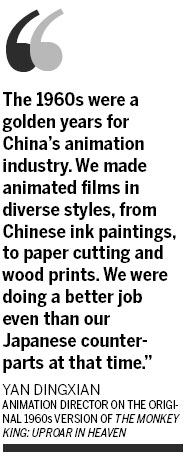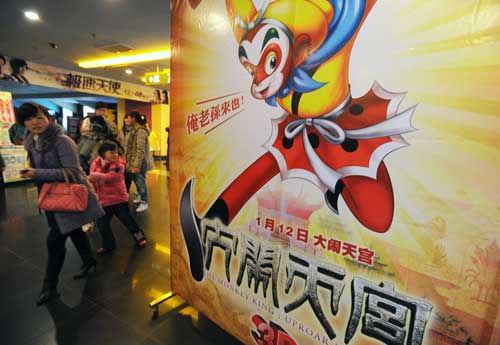Journey in a new dimension
Updated: 2012-01-28 07:19
By Zhang Kun (China Daily)
|
|||||||||||
|
People walk by a poster for The Monkey King: Uproar in Heaven at a cinema in Nanjing, capital of East China's Jiangsu province, on Jan 12. Originally released in 1964, the 3-D remake was released nationwide on Jan 11. You You / For China Daily |
The 3-D remake of The Monkey King: Uproar in Heaven gives the much-loved characters and handcrafted artwork of the original an exciting new action-packed makeover
SHANGHAI - Generation after generation of Chinese children have fallen under the spell of the hand-drawn animation of The Monkey King: Uproar in Heaven, which was painstakingly created in the 1960s. Now, a 3-D remake of this much-loved classic is looking to win the hearts of moviegoers more used to computer-generated images.
"The original movie marked the peak of hand-drawn animation in China, nothing surpassed it," said Ren Zhonglun, president of Shanghai Film Group, which produced the new 3-D movie.
The original animation won China's Baihua Award, and awards in Czechoslovakia and other socialist countries in the 1960s, as well as the Best Film award at the London International Film Festival in 1978.
"We wanted to keep the original style in the 3-D movie, so together with our partner, the American company Technicolor, we developed 3-D technology that preserved the hand-drawn style of the original," Ren said.
The production team also asked 76-year-old Yan Dingxian, who was the animation director on the original, to join the team to ensure the 3-D movie had the same style as the 1960s version.
"At least 200,000 drawings were made for the movie," said Yan, who recalled that when they were drawing the artwork for the original movie, each artist at the Shanghai Animation Film Studio had a mirror on his or her desk so they could copy their own expressions for the characters they were drawing.
"We also had a large mirror in the hallway, where bigger, more complicated body movements could be observed," said Yan, who worked more than 40 years at the studio before retiring.
When the studio celebrated the 80th anniversary of the founding of the Communist Party of China in 2001, Yan and his wife Lin Wenxiao, also an animator, created a painting as a special gift for the occasion, putting together 80 cartoon stars from the studio.
A replica of the piece hangs in the sitting room of Yan's home in a quiet lane on Yongfu Road in Shanghai, and cartoon celebrities, such as the Monkey King, the Black Cat Sheriff, Three Lazy Monks and the Gourd Brothers, looked on as Yan had an interview with China Daily.
In the 1930-40s, the latest movies from Hollywood were screened in cinemas in Shanghai, and as a boy, Yan especially enjoyed the cartoons that played before the main feature, such as Popeye the Sailor, Tom and Jerry, and the Walt Disney characters.
As a teenage art student, Yan joined the first group of animators at the Suzhou Academy of Fine Art. The course was founded by Qian Jiajun, who was making animated movies as early as the 1930s. On graduating Yan joined the newly established Shanghai Animation Film Studio.

"The studio was my graduate school and my co-workers were my tutors and supervisors - it's the best way," Yan said.
"China was closed to the outside world. There were no exchanges, no forums or international conferences. So we just felt our way in the dark."
The studio was the only one of its kind in China at that time, and animators would study old cartoons from Western countries and contemporary work from Russia and other socialist countries.
Te Wei, the founding director of the studio, was impressed with the intricate true-to-life style of Russian animation, and tried to adopt the same technique in his own work, The Proud Marshal. However, the realistic Russian style didn't go well with the story that he wanted to tell.
"It was then he had the idea of learning from China's traditional culture," Yan recalled.
Te Wei, who died in 2010 at the age of 95, encouraged the animators to establish a Chinese style based on traditional Chinese ink painting styles and the study of decorative patterns in Chinese temples and traditional architecture.
"We used to visit temples and sketch the statues and decorative details, such as cloud patterns," Yan recalled.
They also studied Peking Opera, listening to the music and studying the way the actors painted their faces.
"You'll find the walls, carpets and clothing in The Monkey King: Uproar in Heaven are all drawn in a distinctive Chinese style," Yan said.
Wan Laiming (1900-1997), who started producing animations with his twin brother Wan Guchan in the 1920s, joined the Shanghai Animation Film Studio in the 1950s. Impressed with the strong team of animators and eager to create a masterpiece, he proposed a movie based on Journey to the West.
The famous artist and cartoonist Zhang Guangyu was invited to create the characters, because he had studied ancient Chinese and Southeast Asian art, and because he had a cartoon series published based on Journey to the West.
Zhang designed all the demons, fairies and immortals, but none of the three drafts he submitted for the hero, Sun Wukong (the Monkey King) was approved.
Yan adapted Zhang's drafts, and created the image of the mischievous monkey which is recognized by children all over the country: a peach-shaped red outline for his face, in a bright yellow robe, red pants and a pair of black boots.
Yan still keeps one of those early drawings. The paper has aged with dark spots, but the colors and lines are still vivid and clear.
"Animation is all about team work," he said. Eight character animators worked together, with another group working on the backgrounds, and 20 assistants worked on the serial drawings that produced each movement. Yan's wife, Lin, was good at designing body movements for fight scenes.
"The 1960s were golden years for China's animation industry," Yan said. "We made animated films in diverse styles, from Chinese ink paintings, to paper cutting and wood prints. We were doing a better job even than our Japanese counterparts at that time."
Now, China has thousands of animation studios, and hundreds of art academies have animation departments, but China's animation industry has fallen far behind Japan's.
"We have the technology, we have money and we have the talent, it's the imagination that we lack," Yan said.
"So many animators are trying to tell ancient stories all over again, but I think they should tell a modern story: a surrealistic story that explores modern life and emotions."
In the 1960s when China had only one animation studio, Yan and his colleagues recruited stories from all over the country. For instance, a teacher submitted the story for Lin's animation The Snow Child.
"Now many animators are eager to write their own stories, but I think they should be more open-minded, and look for good stories that are already out there," Yan said.
"Dare to think" was Yan's suggestion to young animators. "Imagination plays a key role. It is not only the story that needs it, the style and choreography also require imagination."
He said today's animators need to be more imaginative and be prepared to think outside the box.
"Japan went through a period of copying Western styles, when all the characters were blonde with blue eyes, but then it developed a distinctive style of its own, which is now popular all over the world. Given the time we can do the same."
Today's Top News
President Xi confident in recovery from quake
H7N9 update: 104 cases, 21 deaths
Telecom workers restore links
Coal mine blast kills 18 in Jilin
Intl scholarship puts China on the map
More bird flu patients discharged
Gold loses sheen, but still a safe bet
US 'turns blind eye to human rights'
Hot Topics
Lunar probe , China growth forecasts, Emission rules get tougher, China seen through 'colored lens', International board,
Editor's Picks

|

|

|

|

|

|






